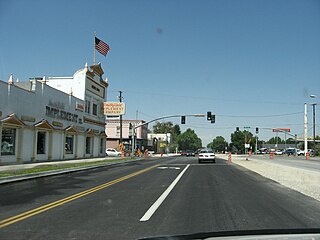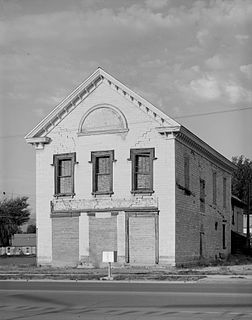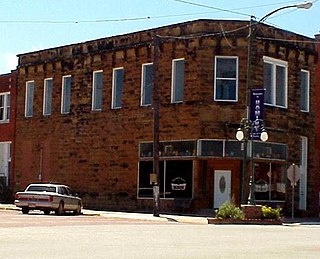
The Bank of Hominy is a building constructed in 1906, two years after the Oklahoma oil boom of 1904. It is one of four small bank buildings built in Richardsonian Romanesque style in Osage County, Oklahoma during 1904-1911. The others are Bank of Burbank, Bank of Bigheart, and Osage Bank of Fairfax.

Allenville Mill Storehouse is a historic mill storehouse at 5 Esmond Street in Esmond, Rhode Island within the town of Smithfield, Rhode Island. The exact date of construction is unknown, but it was built with rubble masonry construction which was typical of mill construction during and after the War of 1812. In 1813, Phillip Allen purchased 4.5 acres of land and constructed a mill on the site, but the first record to specifically refer to the storehouse was an insurance policy from 1836. Allen sold the property in 1857 and it changed ownership several times before it became Esmond Mills in 1906. In 1937, the building was used as a post office and described erroneously as the "Old Allenville Mill". The building has had some alterations to the front door and possibly the addition of a side door, but the interior of the structure was not detailed in the National Register of Historic Places nomination. The Allenville Mill Storehouse was added to the National Register of Historic Places in 1972.

The Brick Tavern House is a former inn on the National Road west of St. Clairsville, Ohio, United States. One of the oldest National Road taverns still in existence, it was built in the early nineteenth century. Although it fell into dilapidation during the late twentieth century, it was named a historic site in 1995, and extensive restoration was to be performed in the early 2010s but to date, has not been.

The J. Vivian Jr. and Company Building is a commercial building located at 342 Hecla Street in Laurium, Michigan. in the Italian Renaissance Revival, and Italianate architectural styles, it was listed on the National Register of Historic Places in 2003.
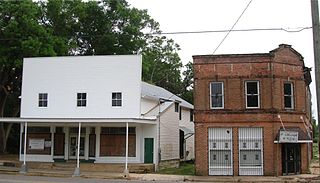
Grand Bay Historic District is a historic district in Grand Bay, Alabama. Listed on the National Register of Historic Places in 1990, the district comprises twelve acres and the three remaining original buildings from Grand Bay's central business district. The buildings include the former Freeland General Store, Grand Bay State Bank, and a small commercial building. The site was once the central business hub of the town and included an L&N passenger station, railway freight station, numerous packing houses, and additional general mercantile businesses.

The Forster Hotel, built in 1870 and expanded in 1913, is a property on the National Register of Historic Places in Mendon, Utah, United States. It was listed on the National Register in 2008 for its historical and architectural qualities.

Muddy Creek Mill is a historic grist mill complex and national historic district located in Tamworth, Cumberland County, Virginia. The district encompasses five contributing buildings and three contributing sites. The mill was built between 1785 and 1792, and is a large two-story structure with two half stories and rests on a down slope basement. It is constructed of sandstone, rubble masonry, and brick. Associated with the mill are a contributing brick store, early-19th century frame miller's house, late-18th century farmhouse and dairy, and the sites of a cooper's shop, blacksmith's shop and saw mill.

The Provo West Co-op is a mercantile institution and also the name of its historic building in Provo, Utah. The Early Commercial-style building was listed on the National Register of Historic Places in 1984 as "Provo West Co-op".
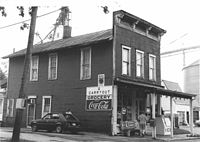
Hamer's General Store was a small commercial building on the eastern side of the village of Mechanicsburg, Ohio, United States. Declared a historic site in the 1980s because of its architecture, it is no longer standing.
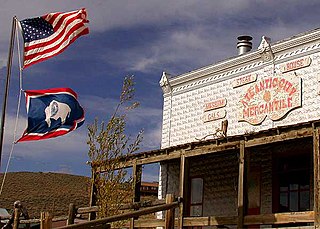
Atlantic City Mercantile is a former store now used as a bar and restaurant in Atlantic City, Wyoming. It is one of the chief buildings in the small mining town in the South Pass area of Wyoming, and is a significant example of a late 19th-century commercial building on what had recently been the frontier.
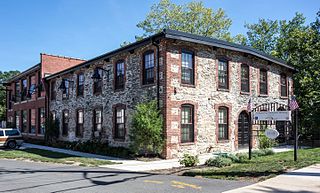
The Heaton and Cowing Mill is a historic industrial facility at 1115 Douglas Avenue in Providence, Rhode Island. The small mill complex consists of three connected building sections; the oldest is a c. 1832 rubble-walled two story mill building constructed by David Heaton and Martin Cowing on the banks of the West River. The partners used the facility to manufacture and dye cotton cloth. The building is the remnant of a much larger Geneva Worsted Company works that Heaton and Cowing built on the site in the 1860s and 1870s. The building was used, with a major brick addition c. 1930, for textile production until the 1950s, until its last textile owner, the Wanskuck Mill, shut down. It served a variety of light industrial businesses, and in 1982 a concrete block building was added to its rear. Most of its original waterworks infrastructure has either been filled in, or was destroyed by flooding in 2010.

The Main Street Commercial District is a historic district in Dothan, Alabama. The district covers 18 acres and portions of 6 blocks in Dothan's historic commercial district. At the time of the nomination, it contained 68 contributing properties, however many have been demolished in the intervening years.

The Southern Mercantile Building is a historic commercial building at 107 East Buchanan in Prairie Grove, Arkansas. It is a single-story brick and masonry structure, with a stuccoed parapet. It consists of two separate buildings, one dating to 1883, that were combined under the unifying parapet about 1920. The building is the largest and best-preserved example of that period's commercial architecture in the city. It served for many years as Prairie Grove's largest and most important general store, finally closing its doors in 1987.

The Mulvey Mercantile is a two-story, red brick commercial building in Yukon, Oklahoma. It was constructed in 1904 as a dry goods store by the Mulvey brothers, and the firm was the largest retail store in the city until the Great Depression. It operated as a hardware store for many years, and is currently occupied by a home decor business.
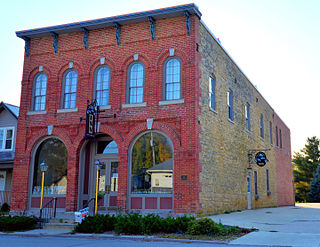
The Wenzil Taylor Building is a historic building located in Spillville, Iowa, United States. Wenzil Taylor had this building constructed in 1871 for use as a general merchandise store. It is located in the town's original commercial district, and it is the last remaining commercial structure from that era. The two-story structure has side and rear walls of rubble limestone with a brick facade. The decorative elements of the Italianate style building features brick arches with dressed limestone keystones, recessed brick panels, and brick pilasters The bracketed cornice is a recreation. It continued to house a merchandise store for most of its history, and was used as a residence before it was abandoned. The building was listed on the National Register of Historic Places in 1979. After its restoration it became a restaurant.

The Railroad Street Historic District encompasses a cluster of commercial and railroad-related buildings at the traditional late 19th-century heart of St. Johnsbury, Vermont. It includes five commercial buildings and the town's 1883 union depot, and is reflective of the town's importance as a major railroad junction in northern New England. The district was listed on the National Register of Historic Places in 1974. It was subsumed by the larger St. Johnsbury Historic District in 1980.
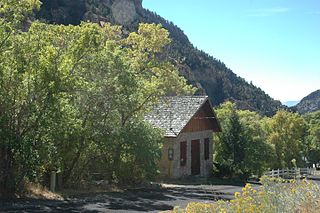
The Lawrence Brothers and Company Store is a historic commercial building in Ophir, Utah, United States, that is listed on the National Register of Historic Places.

The Emporium is a commercial building located at 154-156 West Michigan Avenue in Marshall, Michigan. It was listed on the National Register of Historic Places in 1979.

The Daft Block, also known as the Daynes Jewelry Building, in Salt Lake City, Utah, is a 4-story Richardsonian Romanesque commercial building designed by Elias L. T. Harrison and H.W. Nichols and constructed 1887-1889. The brick building is trimmed with sandstone sills and lintels, and it features a prominent, two-story bay window. Above the bay window is a decorative sandstone pediment. The building was added to the National Register of Historic Places in 1976.

The Hobson-Hill House, at 108 South 100 West in Richmond, Utah, wwas listed on the National Register of Historic Places in 2004. It has also been known as the Louis & Clara Merrill House and as the George & Maud Bair House. The listing included three contributing buildings.

